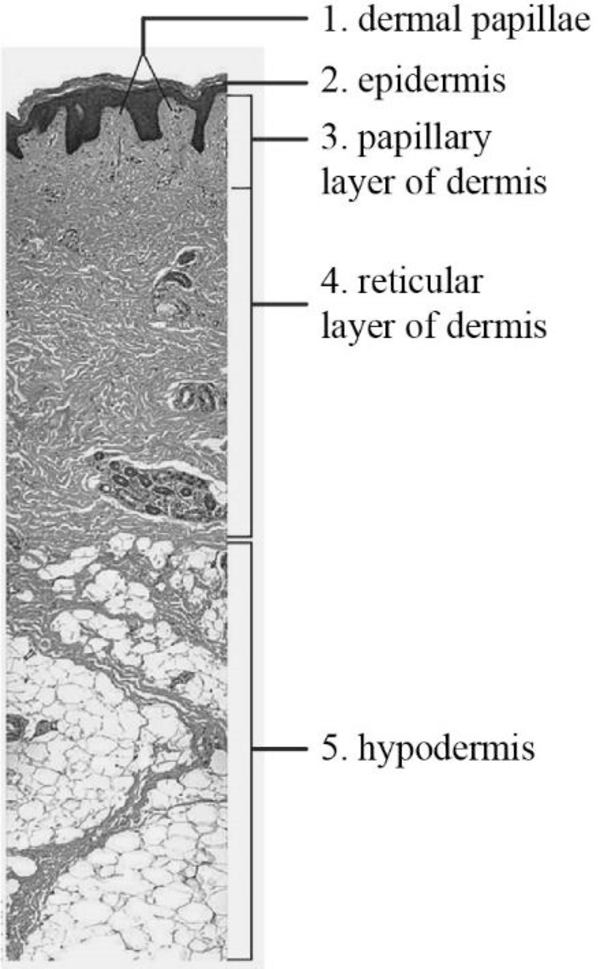
To label: The skin structure.
Introduction: The integumentary system includes skin, the largest organ that covers the entire body. The skin is made up of multiple layers, the outer epidermis, the middle dermis, and the inner hypodermis layers. The epidermis contains cells, such as Merkel cells, Langerhans cells, keratinocytes, and melanocytes. The function of the epidermis is to act as a barrier against the pathogens. The dermis layer provides nutrients to the epidermal layer and connects the epidermal layer with the innermost hypodermis.
Answer to Problem 1.1BGL
Pictorial representation:

Parts of the skin
Explanation of Solution
The skin and its associated structures play many important roles in the body that includes protection, production of vitamin D, excretion, and maintenance of body temperature. The skin structure includes dermal papillae, epidermis, papillary layer of the dermis, the reticular layer of the dermis, and the hypodermis.
Dermal papillae: It is the folding of the dermal papillary layer that increases the surface area of the skin.
Epidermis: It is the outermost layer of the skin, chiefly composed of keratinocytes (nearly 95%). It is a tough layer and acts as a good barrier.
Papillary layer: This layer lies next to the epidermis, and it is the sublayer of the dermis. It is composed of the dermal papillae and areolar connective tissue.
Reticular layer: The layer next to the papillary layer is the reticulate layer that is made up of dense irregular connective tissue that provides strength and elasticity.
Hypodermis: It is the deepest layer of skin that is also called subcutaneous layer.
The basement membrane lies between the epidermis and the dermal papillae of the dermis.
Want to see more full solutions like this?
Chapter 7 Solutions
Laboratory Manual for Anatomy and Physiology, 6e Loose-Leaf Print Companion
 Human Anatomy & Physiology (11th Edition)BiologyISBN:9780134580999Author:Elaine N. Marieb, Katja N. HoehnPublisher:PEARSON
Human Anatomy & Physiology (11th Edition)BiologyISBN:9780134580999Author:Elaine N. Marieb, Katja N. HoehnPublisher:PEARSON Biology 2eBiologyISBN:9781947172517Author:Matthew Douglas, Jung Choi, Mary Ann ClarkPublisher:OpenStax
Biology 2eBiologyISBN:9781947172517Author:Matthew Douglas, Jung Choi, Mary Ann ClarkPublisher:OpenStax Anatomy & PhysiologyBiologyISBN:9781259398629Author:McKinley, Michael P., O'loughlin, Valerie Dean, Bidle, Theresa StouterPublisher:Mcgraw Hill Education,
Anatomy & PhysiologyBiologyISBN:9781259398629Author:McKinley, Michael P., O'loughlin, Valerie Dean, Bidle, Theresa StouterPublisher:Mcgraw Hill Education, Molecular Biology of the Cell (Sixth Edition)BiologyISBN:9780815344322Author:Bruce Alberts, Alexander D. Johnson, Julian Lewis, David Morgan, Martin Raff, Keith Roberts, Peter WalterPublisher:W. W. Norton & Company
Molecular Biology of the Cell (Sixth Edition)BiologyISBN:9780815344322Author:Bruce Alberts, Alexander D. Johnson, Julian Lewis, David Morgan, Martin Raff, Keith Roberts, Peter WalterPublisher:W. W. Norton & Company Laboratory Manual For Human Anatomy & PhysiologyBiologyISBN:9781260159363Author:Martin, Terry R., Prentice-craver, CynthiaPublisher:McGraw-Hill Publishing Co.
Laboratory Manual For Human Anatomy & PhysiologyBiologyISBN:9781260159363Author:Martin, Terry R., Prentice-craver, CynthiaPublisher:McGraw-Hill Publishing Co. Inquiry Into Life (16th Edition)BiologyISBN:9781260231700Author:Sylvia S. Mader, Michael WindelspechtPublisher:McGraw Hill Education
Inquiry Into Life (16th Edition)BiologyISBN:9781260231700Author:Sylvia S. Mader, Michael WindelspechtPublisher:McGraw Hill Education





